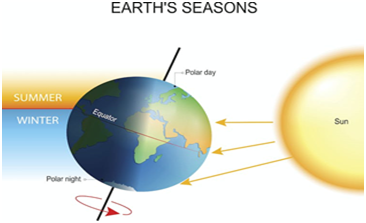

Context
Above the equator, winter officially begins in December, but in many areas, January is when it really takes hold which is mainly due to the earth’s tilt and it seems to be different for different locations on earth.
About
About the earth’s axial tilt:
- Earth's axial tilt (also known as the obliquity of the ecliptic) is about 5 degrees.
- Due to this axial tilt, the sun shines on different latitudes at different angles throughout the year.
- The earth's spin axis is tilted with respect to its orbital plane.
- This is what causes the seasons. When the earth's axis points towards the sun, it is summer for that hemisphere. When the earth's axis points away, winter can be expected.
How does the Earth’s orbit influence our daylight and temperatures?
- As the Earth orbits the sun, it spins around an axis from the North Pole to the South Pole.
- During the 24 hoursthat it takes for the Earth to rotate once around its axis, every point on its surface faces toward the Sun for part of the time and away from it for part of the time. This is what causes daily changes in sunlight and temperature.
- There are two other important factors:
- First, the Earth is round,although it’s not a perfect sphere.
- Second, its axis is tilted about 23.5 degreesrelative to its path around the Sun.
- As a result, light falls directly on its equatorbut strikes the North and South poles at angles.
- When one of the poles points more toward the Sun than the other pole, that half of the planet gets more sunlight than the other half, and it’s summer in that hemisphere.
- When that pole tilts away from the Sun, that half of the Earth gets less sunlight and it’s winter there.
Impact on earth due to the tilt
- Existence of seasons:As the Earth orbits the Sun, sunlight strikes the surface at varying angles because of the planet’s tilt. This creates seasons.
|
- Changes in Wind directions: As the Earth rotates; air circulates around it in the atmosphere. Mostly, in the northern hemisphere, the air comes from the Arctic region which is comparably cold.
- Distribution of Sunlight:
- At Poles: Seasonal changes are the most dramatic at the poles, where the changes in light are the most extreme. During the summer, a pole receives 24 hours of sunlight and the Sun never sets. In the winter, the Sun never rises at all.
- At the Equator: At the equator, which gets consistent direct sunlight, there’s very little change in day length or temperature year-round. People, who live in high and middle latitudes, closer to the poles, can have very different ideas about seasons from those who live in the tropics.

